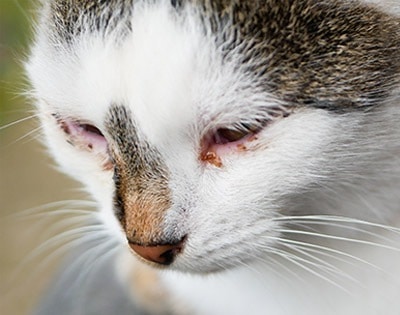
What is Feline Calicivirus?
Also known as: FCV
Feline calicivirus is a highly contagious virus in cats and one of the leading causes of respiratory infection. It can also cause oral disease. Because the virus can mutate and develop new strains, much like the human flu, vaccines are not always effective.
Aerapy Animal Health’s UV sanitizing technology was tested against feline calicivirus and achieved a >99.996% kill rate.
Visit our Research & Studies page to learn more.
How is feline calicivirus transmitted?
FCV can be transmitted through multiple routes.
Spread through the air.
Feline calicivirus can be spread through the air by droplets and droplet nuclei that are released when a cat sneezes. While most of the droplets fall to the ground, contaminating the surface on which it lands, the virus can also survive on tiny dust particles or dander and survive for hours traveling throughout your facility until inhaled by another host. Once ingested, these agents begin to wreak havoc within the upper respiratory tract.
Contact with contaminated objects.
If an infected cat drinks from a watering dish or uses a litter box, and another cat comes in contact with these objects, he could easily contract feline calicivirus. Proper sanitation is critical in keeping your animals healthy. Failing to wipe down counters or thoroughly wash feeding dishes could cause animals in your care to develop this nasty ailment.
Direct contact with infected cats.
If a healthy cat comes in contact with an infected cat’s saliva, eye or nasal discharge, or feces, the chances are high the healthy cat will become infected. Boarding facilities, daycares, and other businesses where numerous animals are kept in close quarters, must take extra precautions to protect their facilities from the transmission of feline calicivirus. If you suspect a cat is infected, isolate him immediately.
What are the symptoms of feline calicivirus?
Different strains of feline calicivirus cause different symptoms with varying severity including discharge from the eyes and nose, fever, sores in the mouth, loss of appetite, lethargy, and, in extreme cases, limping.
A severe form called virulent systemic feline calicivirus (VS-FCV) has been found in shelters or in environments where many cats are housed together. This form is very contagious and can be fatal. Symptoms associated with VS-FCV are sores on the skin, fluid buildup in the skin (edema), vomiting, diarrhea, jaundice, and signs of pneumonia.
How can feline calicivirus be prevented?
Because vaccines are not always effective, being proactive is key in the prevention of feline calicivirus. Pet care facilities should have air purification systems and surface disinfection protocols in place. Pet parents should carefully choose pet care. Ask about air and surface sanitation protocols used to help stop or control the spread of FCV and other illnesses.
For more information and details for both pet care facilities and pet parents on how best to prevent the spread of infectious disease, visit our kennel cough page.
How is feline calicivirus treated?
The following is not intended as a substitute for professional medical advice, diagnosis, or treatment for your pet. Consult your veterinarian for questions and information regarding your pet’s health.
According to Cornell University’s College of Medicine, currently there is no treatment to stop calicivirus, but supportive care can be offered while a cat’s immune system fights the infection. Most cats can recover at home, but severely affected cats may need intensive nursing care, including those that develop VS-FCV.
Supportive care can include keeping the nose and eyes clean and helping reduce congestion with vaporizers, saline nose drops, and drugs that break down mucus, like bromhexine. Fever can be lowered, and mouth pain reduced, with non-steroidal anti-inflammatory drugs. Further, because congestion and mouth sores may cause loss of appetite, strong-smelling, soft foods can be pureed to make them easier to eat and slightly heated to increase their odor. (Source)
FELINE CALICIVIRUS QUICK LINKS
How is feline calicivirus transmitted?
FCV can be transmitted through multiple routes.
Spread through the air.
Feline calicivirus can be spread through the air by droplets and droplet nuclei that are released when a cat sneezes. While most of the droplets fall to the ground, contaminating the surface on which it lands, the virus can also survive on tiny dust particles or dander and survive for hours traveling throughout your facility until inhaled by another host. Once ingested, these agents begin to wreak havoc within the upper respiratory tract.
Contact with contaminated objects.
If an infected cat drinks from a watering dish or uses a litter box, and another cat comes in contact with these objects, he could easily contract feline calicivirus. Proper sanitation is critical in keeping your animals healthy. Failing to wipe down counters or thoroughly wash feeding dishes could cause animals in your care to develop this nasty ailment.
Direct contact with infected cats.
If a healthy cat comes in contact with an infected cat’s saliva, eye or nasal discharge, or feces, the chances are high the healthy cat will become infected. Boarding facilities, daycares, and other businesses where numerous animals are kept in close quarters, must take extra precautions to protect their facilities from the transmission of feline calicivirus. If you suspect a cat is infected, isolate him immediately.
What are the symptoms of feline calicivirus?
Different strains of feline calicivirus cause different symptoms with varying severity including discharge from the eyes and nose, fever, sores in the mouth, loss of appetite, lethargy, and, in extreme cases, limping.
A severe form called virulent systemic feline calicivirus (VS-FCV) has been found in shelters or in environments where many cats are housed together. This form is very contagious and can be fatal. Symptoms associated with VS-FCV are sores on the skin, fluid buildup in the skin (edema), vomiting, diarrhea, jaundice, and signs of pneumonia.
How can feline calicivirus be prevented?
Because vaccines are not always effective, being proactive is key in the prevention of feline calicivirus. Pet care facilities should have air purification systems and surface disinfection protocols in place. Pet parents should carefully choose pet care. Ask about air and surface sanitation protocols used to help stop or control the spread of FCV and other illnesses.
For more information and details for both pet care facilities and pet parents on how best to prevent the spread of infectious disease, visit our kennel cough page.
How is feline calicivirus treated?
The following is not intended as a substitute for professional medical advice, diagnosis, or treatment for your pet. Consult your veterinarian for questions and information regarding your pet’s health.
According to Cornell University’s College of Medicine, currently there is no treatment to stop calicivirus, but supportive care can be offered while a cat’s immune system fights the infection. Most cats can recover at home, but severely affected cats may need intensive nursing care, including those that develop VS-FCV.
Supportive care can include keeping the nose and eyes clean and helping reduce congestion with vaporizers, saline nose drops, and drugs that break down mucus, like bromhexine. Fever can be lowered, and mouth pain reduced, with non-steroidal anti-inflammatory drugs. Further, because congestion and mouth sores may cause loss of appetite, strong-smelling, soft foods can be pureed to make them easier to eat and slightly heated to increase their odor. (Source)





